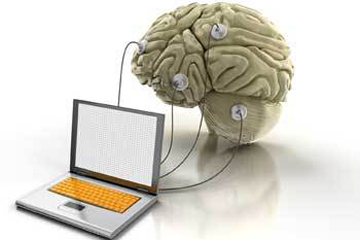![uploading[1]](https://i0.wp.com/indiafuturesociety.org/wp-content/uploads/2013/11/uploading1.png?resize=297%2C300&ssl=1) Mind uploading or whole brain emulation (sometimes called mind transfer) is the hypothetical process of scanning and mapping a biological brain in detail and copying its state into a computer system or another computational device. The computer would have to run a simulation model so faithful to the original that it would behave in essentially the same way as the original brain, or for all practical purposes, indistinguishably ( p., 24).
Mind uploading or whole brain emulation (sometimes called mind transfer) is the hypothetical process of scanning and mapping a biological brain in detail and copying its state into a computer system or another computational device. The computer would have to run a simulation model so faithful to the original that it would behave in essentially the same way as the original brain, or for all practical purposes, indistinguishably ( p., 24).
Mind uploading is deemed as a logical endpoint for many of those in the in transhumanist and life extension circles. The term was originally suggested in biomedical literature in 1971, so the concept has been around a few decades but still abstract to many. Substantial mainstream research and development are however being done in relevant areas including development of faster super computers, virtual reality, brain-computer interfaces, animal brain mapping and simulation, and information extraction from dynamically functioning brains (p., 24).
The question of mind uploading is highly debated by philosophers, and contradicts the dualist of the human mind that is common in many religions, but then again religion has no place in reality.
The concept of mind uploading is based on the mechanistic view of the mind, and denies the vitalist view of human life and consciousness. “Consciousness is part of the natural world. It depends, we believe only on mathematics and logic and on the imperfectly known laws of physics, chemistry, and biology; it does not arise from some magical or otherworldly quality” (p., 25). Even though we do acknowledge that consciousness is not just confined within the biological parameters of the brain and human anatomy, it is in our best interest to emulate as much of the physical properties of the mind as possible in attempting to creating a mind, or copying a mind to a computational substrate. Converging science disciplines will allow the mechanistic and vitalist research to become collaborative in nature and allows the possibility of mind uploading that much more plausible, and perhaps in the near future, even practical.
The amount of storage and computational power required for mind uploading is quite astounding and at the current time is difficult to predict, but several theoretical scientists have presented models describing how much would be needed based on their own calculations. Using these particular models, some of them have estimated that mind uploading may become possible within decades if trends such as Moore’s Law continues. Although Moore’s Law has been fairly accurate on the exponential change of computer transistors and computational processing power, Moore’s Law does not extend beyond these types of computing. Quantum computing will allow us to get much closer to actual mind uploading due to the nature of its potential hardware not running from transistors, but the quantum energy that exists all around us, and allows for much more complexity and depth of models and simulations, with the possibility of mind uploading included.
Benefits of Mind Uploading

If the information and processes of the mind can be disassociated from the biological body, then they are no longer tied to the individual limits and lifespan of that body. Information within a brain could be partly or wholly. Opined or transferred to one or more other substrates, including digital storage or another brain, thereby reducing or eliminating mortality risk. This general proposal was first made in 1971by renowned University of Washington bio gerontologist George M. Martin. For transhumanists, this is just one possibly method of becoming post human, living on in a different form of yourself via a computational substrate.
A possible benefit of mind uploading is the possibility of running more than one copy of a human mind existing at once. Such copies could potentially allow an individual to experience many things at once. And later integrate the experiences of all copies into a central mentality at some point in the future, effectively allowing a single sentiment being to be many places at once, and do many things at once; this concept has been explored in fiction. Such partial and complete copies of a sentiment being raise interesting questions regarding identity and individuality (p., 26).
Issues of Mind Uploading
The Bekenstein bound is an upper limit on information that can be contained within a given finite region of space, which has finite amount of energy, or conversely, the maximum amount of information required to perfectly describe a given physical system down to the quantum level. I won’t get into the theoretical and physics math involved, but just know that it represents the maximum information needed to perfectly recreate the average human brain down to the quantum level, and will list further reading resources at the end of this article.
No matter the techniques used to capture or recreate the all of the functions of a human brain , the demands of a computational process are immense, directly related to the huge number of neurons within the human brain and the innate complexity of each one of those neurons in completing human movement and thought. Henry Markram,lead researcher of the Blue Brain Project has this to say:
“It will be very difficult because, in the brain, every molecule is a powerful computer and we would need to simulate the structure and function of trillions upon trillions of molecules as well as all the rules that govern how they interact. You would literally need computers that are trillions of times bigger and faster than anything existing today” (p., 27).

Those whom are advocating and supporting the possibility, and advancement of research and development of mind uploading point to Moore’s Law, that the necessary computing will become available in the coming decades. We need more people in the STEM fields dedicated to the advancement of computing power, and many nations across the world are recognizing the increasingly demanding need for people dedicated to STEM, where are vital converging technologies.
Part 2 of this article will discuss:
Philosophical issues, including copying v moving
Legal and economic issues
Relevant technologies and techniques
Current Research
Criticisms of mind-uploading
The next article will obviously be much lengthier, so it will take longer to write, but hopefully this article has sparked some interest. Below are some further reading suggestions:
http://www.benbest.com/philo/doubles.html
Tags: Brain Enhacement, Mind Uploading












[…] Mind uploading or whole brain emulation (sometimes called mind transfer) is the hypothetical process of scanning and mapping a biological brain in detail and copying its state into a computer syste… […]